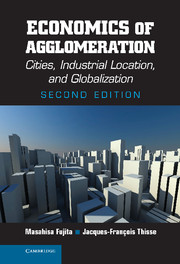Book contents
- Frontmatter
- Dedication
- Contents
- Acknowledgments
- Preface to the Second Edition
- 1 Agglomeration and Economic Theory
- Part I Fundamentals of Spatial Economics
- 2 The Breakdown of the Price Mechanism in a Spatial Economy
- 3 The von Thünen Model and Land Rent Formation
- 4 Increasing Returns and Transport Costs: The Fundamental Trade-off of a Spatial Economy
- 5 Cities and the Public Sector
- Part II The Structure of Metropolitan Areas
- Part III Factor Mobility and Industrial Location
- Part IV Urban Systems, Regional Growth, and the Multinationalization of Firms
- References
- Author Index
- Subject Index
4 - Increasing Returns and Transport Costs: The Fundamental Trade-off of a Spatial Economy
Published online by Cambridge University Press: 05 August 2013
- Frontmatter
- Dedication
- Contents
- Acknowledgments
- Preface to the Second Edition
- 1 Agglomeration and Economic Theory
- Part I Fundamentals of Spatial Economics
- 2 The Breakdown of the Price Mechanism in a Spatial Economy
- 3 The von Thünen Model and Land Rent Formation
- 4 Increasing Returns and Transport Costs: The Fundamental Trade-off of a Spatial Economy
- 5 Cities and the Public Sector
- Part II The Structure of Metropolitan Areas
- Part III Factor Mobility and Industrial Location
- Part IV Urban Systems, Regional Growth, and the Multinationalization of Firms
- References
- Author Index
- Subject Index
Summary
INTRODUCTION
A higher density of economic activity typically means higher land rent and commuting costs for which workers must be compensated. For firms to pay them higher wages, they must derive some advantages from being agglomerated, e.g., within the CBD. The source of these advantages lies in the presence of various types of scale economies. As they take very different forms, they are likely to elude a superficial analysis. Increasing returns may be “internal” or “external” to firms. Internal scale economies are found in a wide variety of sectors. For example, they are characteristic of certain public services (e.g., large general hospitals and universities) as well as many private businesses in a range of sectors extending far beyond the heavy industries of the nineteenth century. These cases all involve firms' internal economies of scale, which, thanks to costly but efficiency-raising investments, provide incentive to concentrate production in a small number of plants or facilities. Increasing returns at the firm level are central to NEG (see Chapter 8) as well as to spatial competition theory (see Section 4.5).
As seen in Chapter 2, a homogeneous space together with the competitive mechanism is not compatible with the existence of economic agglomerations such as cities. This is why we broached the assumption of homogeneity in Chapter 3 by assuming the existence of a prespecified center to which workers must commute. We did not, however, provide any justification for the existence of such a center.
- Type
- Chapter
- Information
- Economics of AgglomerationCities, Industrial Location, and Globalization, pp. 99 - 148Publisher: Cambridge University PressPrint publication year: 2013



